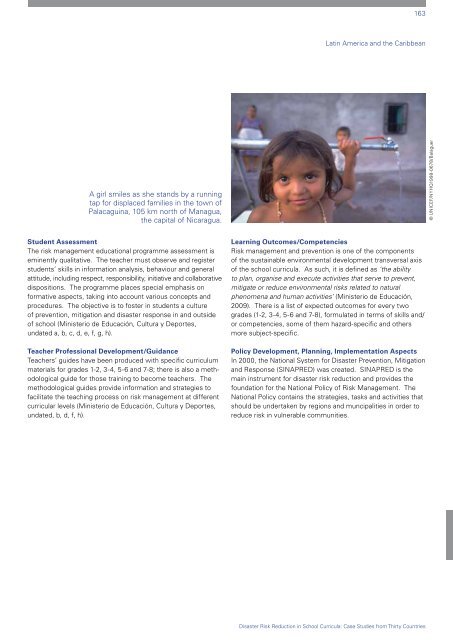Disaster Risk Reduction in School Curricula: Case Studies ... - Unicef
Disaster Risk Reduction in School Curricula: Case Studies ... - Unicef
Disaster Risk Reduction in School Curricula: Case Studies ... - Unicef
Create successful ePaper yourself
Turn your PDF publications into a flip-book with our unique Google optimized e-Paper software.
163<br />
Lat<strong>in</strong> America and the Caribbean<br />
A girl smiles as she stands by a runn<strong>in</strong>g<br />
tap for displaced families <strong>in</strong> the town of<br />
Palacagu<strong>in</strong>a, 105 km north of Managua,<br />
the capital of Nicaragua.<br />
© UNICEF/NYHQ1998-0678/Balaguer<br />
Student Assessment<br />
The risk management educational programme assessment is<br />
em<strong>in</strong>ently qualitative. The teacher must observe and register<br />
students’ skills <strong>in</strong> <strong>in</strong>formation analysis, behaviour and general<br />
attitude, <strong>in</strong>clud<strong>in</strong>g respect, responsibility, <strong>in</strong>itiative and collaborative<br />
dispositions. The programme places special emphasis on<br />
formative aspects, tak<strong>in</strong>g <strong>in</strong>to account various concepts and<br />
procedures. The objective is to foster <strong>in</strong> students a culture<br />
of prevention, mitigation and disaster response <strong>in</strong> and outside<br />
of school (M<strong>in</strong>isterio de Educación, Cultura y Deportes,<br />
undated a, b, c, d, e, f, g, h).<br />
Teacher Professional Development/Guidance<br />
Teachers’ guides have been produced with specific curriculum<br />
materials for grades 1-2, 3-4, 5-6 and 7-8; there is also a methodological<br />
guide for those tra<strong>in</strong><strong>in</strong>g to become teachers. The<br />
methodological guides provide <strong>in</strong>formation and strategies to<br />
facilitate the teach<strong>in</strong>g process on risk management at different<br />
curricular levels (M<strong>in</strong>isterio de Educación, Cultura y Deportes,<br />
undated, b, d, f, h).<br />
Learn<strong>in</strong>g Outcomes/Competencies<br />
<strong>Risk</strong> management and prevention is one of the components<br />
of the susta<strong>in</strong>able environmental development transversal axis<br />
of the school curricula. As such, it is def<strong>in</strong>ed as ‘the ability<br />
to plan, organise and execute activities that serve to prevent,<br />
mitigate or reduce environmental risks related to natural<br />
phenomena and human activities’ (M<strong>in</strong>isterio de Educación,<br />
2009). There is a list of expected outcomes for every two<br />
grades (1-2, 3-4, 5-6 and 7-8), formulated <strong>in</strong> terms of skills and/<br />
or competencies, some of them hazard-specific and others<br />
more subject-specific.<br />
Policy Development, Plann<strong>in</strong>g, Implementation Aspects<br />
In 2000, the National System for <strong>Disaster</strong> Prevention, Mitigation<br />
and Response (SINAPRED) was created. SINAPRED is the<br />
ma<strong>in</strong> <strong>in</strong>strument for disaster risk reduction and provides the<br />
foundation for the National Policy of <strong>Risk</strong> Management. The<br />
National Policy conta<strong>in</strong>s the strategies, tasks and activities that<br />
should be undertaken by regions and muncipalities <strong>in</strong> order to<br />
reduce risk <strong>in</strong> vulnerable communities.<br />
<strong>Disaster</strong> <strong>Risk</strong> <strong>Reduction</strong> <strong>in</strong> <strong>School</strong> <strong>Curricula</strong>: <strong>Case</strong> <strong>Studies</strong> from Thirty Countries

















